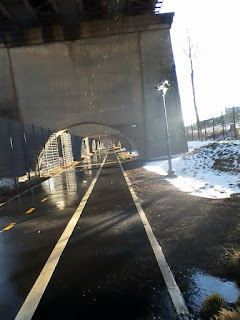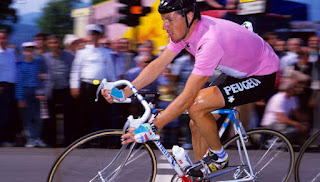You know you're an adult when you make the same mistakes as your parents made.
Sometimes it seems that policy-makers define "progress" in a similar way. Your city is becoming as big, important and hip as the "big boys" when it emulates their policy and legislative blunders.
At least, it seems that way whenever a city wants to tout itself as "bicycle friendly". Hardly a day goes by without my learning that some municipality or another tries to show that its affinity for bicycles and cyclists. The other day Houston was making its declaration of love. So was Durham, North Carolina.
The enlightened leaders of both metropoli seem to think an alliance with cyclists seems to involve the same things. One is "encouraging ridership", whatever that means. Another is building more bike lanes.
The latter always seems to be accepted as the ultimate sign that someone's fair city really and truly wants to make the world--or, at least, its world--safe for cycling. Surely, they believe, riding in a designated bike lane is better than riding in traffic. Even if that lane is poorly maintained. Even if there's nothing to stop cars and trucks from parking in it. Even if it leads into a turn more dangerous than anything a cyclist would have to navigate from the main roadway. Even if it ends, without warning, in the middle of a block.
Or even if that lane is a "contraflow" lane: a one-way street turned into a roadway shared with bicycle traffic running in the opposite direction from the motor vehicle traffic.
Welcome, Durham, to the Pantheon of Bicycle-Friendly Cities in the United States. With friends like you, we don't need enemies!
Sometimes it seems that policy-makers define "progress" in a similar way. Your city is becoming as big, important and hip as the "big boys" when it emulates their policy and legislative blunders.
At least, it seems that way whenever a city wants to tout itself as "bicycle friendly". Hardly a day goes by without my learning that some municipality or another tries to show that its affinity for bicycles and cyclists. The other day Houston was making its declaration of love. So was Durham, North Carolina.
The enlightened leaders of both metropoli seem to think an alliance with cyclists seems to involve the same things. One is "encouraging ridership", whatever that means. Another is building more bike lanes.
 |
| Photo by Marlo Stimpson |
The latter always seems to be accepted as the ultimate sign that someone's fair city really and truly wants to make the world--or, at least, its world--safe for cycling. Surely, they believe, riding in a designated bike lane is better than riding in traffic. Even if that lane is poorly maintained. Even if there's nothing to stop cars and trucks from parking in it. Even if it leads into a turn more dangerous than anything a cyclist would have to navigate from the main roadway. Even if it ends, without warning, in the middle of a block.
Or even if that lane is a "contraflow" lane: a one-way street turned into a roadway shared with bicycle traffic running in the opposite direction from the motor vehicle traffic.
Welcome, Durham, to the Pantheon of Bicycle-Friendly Cities in the United States. With friends like you, we don't need enemies!



















